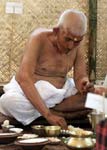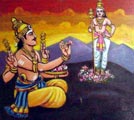 |
|
|
|
 |
| Nepal's Festivals |
 |
| Indra Jatra |
| Kathmandu: People celebrate Indra Jatra with enthusiasm |
Hundreds of devotees throng the local Basantapur and Indrachowk to have a darsan (glimpse) and prasad of the facial image of Bhairab displayed at different places of the area during the Indra Jatra festival. The gathering of the local people has been continuing from the beginning of the Indra Jatra which was marked first by hoisting a lingo (pole). A large number of people visit local Indrachowk to have a glance of Aakash Bhairab and Swet Bhairab displayed during the festival of Indra Jatra. On the occasion, devotees take jaand (local beer) and samaya-baji distributed among the devotees.
There is a tradition that from the first day of the festival images of Gods Bhairab and Indra, the rain god, are displayed at different places of the Durbar Square area in commemoration of the Rain God Indra. The Newar community considers Indra and Bhairab as one god with two appearances. The tradition also has it that the image of Bhairab is brought out from each house or temple for display during the festival. It is believed that by displaying Indra and Bhairab, they are extending thanks to the rain god for good harvest.
On the occasion, the huge facial image of Swet Bhairab is also put on display which otherwise remains closed for the whole year. From the first day of the festival the huge head will remain opened for the festival. According to the scripture placed under the image of Bhairab, the image was made during the reign of King Rana Bahadur Shah. The periphery behind the temple was a cremation ground (deep in the Newari language) during the rule of King Rana Bahadur Shah.
Whenever King came out of his palace, he used to see the cremation of dead person every day. He used to return thinking the scene as a bad omen. Then to do away with cremation there, he installed Swet Bhairab just in front of the main gate. The temple is just in front of Degu Telaju temple. The entrance still remains there just behind Swet Bhairab.It was a belief that white is good omen and therefore is considered god.
The
legend also has it that people used to get frightened of great facial image
so it is closed throughout the year. There is also a belief that Swet Bhairab
wore precious jewelry so it was kept in close wooden curtain for security.
One Gurju (priest of Buddhist clan) worship Bhairab every day inside the
wooden curtain. In special puja one goat, one ox and one duck are sacrificed.
The method is given in the Shila Patra (traditional book), he says.
On the eve of Indra Jatra, care-takers will clean up the image and sacrifice the animals from one window among the nine closed windows. They open the window amidst the beats of traditional musical instruments of dhime and jogi on the first day of Indra Jatra.
At Kumari Jatra, that falls on the third and fourth day of Indra Jatra, the ghuthiyars (care-takers) of Swet Bhairab will prepare the samaya bagi (mixture of five traditional food items) and jaand (traditional beer) as prasad. In Aakash Bhairab also they prepare the same prasad. Great competition takes place among the people to get few drops of prasad (jaand) of Swet Bhairab. They don't take prasad from Aakash Bhairab because there is a tradition that all the jaand poured from the mouth of the image is sent to Patal Lok (below the earth).
In this way, people celebrate the festival in the Hanumandhoka area along with Lakhe, Bhairab and Devi dances with full enthusiasm. The beats of traditional musical instrument are also heard in the periphery when the evening falls.
| Former King Gyanendra offers puja to Kumari |
Thousands of people gathered at the Basantapur Durbar Square in central Kathmandu today to observe the Rath Yatra (Chariot Festival) of Kumari, Ganesh and Bhairab on the occasion of Indra Jatra. Their Majesties King Gyanendra and Queen Komal and other members of the former Royal Family graced the Rath Yatra of new Kumari, the Living Goddess of Nepal. The former King and Queen threw coins from the balcony of Basantapur Durbar to have a darshan (pay homage) of the Goddess. Then the chariot, carrying the Kumari, went around the main thoroughfares of the Capital. Even the diplomats and other high-ranking government officials got this rare opportunity of having a darshan of Goddess Kumari.
Thousands of people, including the tourists, braved the drizzle to gather at the periphery to watch this traditional chariot festival, held once a year. Indra Jatra, primarily celebrated by the Newar community in the Capital, is considered to be the most important festival, prior to the biggest festival of Dashain.
The third day of the eight-day Indra Jatra, is the most important day as the Goddess Kumari is taken out of the Kumari House in a chariot. Before taking out in a chariot, Pancha Buddha (mainly from Bajracharya community) offered a special puja to the Goddess in a secret function. Then Ganesh and Bhairab were brought out of their respective houses in different chariots amidst the beat of traditional musical instruments. Before the start of chariot festival, goats were sacrificed at each wheel of the chariots and were offered puja so that the chariots would not meet an accident during the procession.
The third day's Yatra is also called Koniya Jatra. This is because the chariots moved only towards the southern part of the city like Chikanmugal, Lagan Tole, etc. On the fourth day, Thaniya Jatra would be held, when the chariots would be taken through the northern part of the city. Starting from the Kumari House at Basantapur, the chariots would be taken through places like Pyaphal, Yatkha, Nardevi, Tangal, Bangemudha, Ason, Keltole, Indrachowk, Makhan, Hanumandhoka and back to Kumari House. Panche Baja, the traditional music and a military band accompanied the chariots. Raj Khadga (a traditional Royal Sword representing the King) is also taken along with the chariot. When the chariot of Kumari reached in front of the Bhairab temples, displayed at different places from the first day of the festival, then the people hustled for Jaad (traditional liquor) poured from the Bhairab's mouth. A pipe is fixed on the mouth of Bhairab from where the liquor is poured, people say.
Newars in the Valley invited their relatives and close ones to their homes as they organized a feast at the places where the chariot of the Kumari reached today. Then after the evening puja, the family members of those deceased in a year go around different parts of the Valley lighting oil lamps (Pala) at different parts of the city in their memory.
| Lakhe dance : A colourful part of Indra Jatra |
Various mask dances of Lakhe, Pulu Kisi, Mahakali, Dash Avatar and Bhairab are performed throughout the eight-day festival of Indra Jatra. The Lakhe dance is the most interesting part of the festival because of its violent dance, chase and fake fight with masked Bhairab and Pulu Kisi. Along with the dancing and celebration, fighting between the two different groups of mask dancers is also common. Fighting among two different groups used to turn realistic which, in fact, should have been fake. The fake fight turns real when two opposite groups meet, because of groupism among the Tole (community) boys.
The Lakhe danceThe Lakhe dance begins from the first day of hoisting of the lingo ( wooden pole) and continues throughout the eight days of the festival. From the first day, every evening large number of people visit Basantapur for prasad and to watch the violent dance of Lakhe. Dressed in red, Lakhe moves his hands and legs in mesmerising rhythms, being unaware of the audience gathered around him.
The heavy mask, the red hair and heavy ornaments around
his neck and waist become light when the spell of the "demon" overpowers
his physical entity. As he starts dancing, running from one point to another,
he is followed by a noisy audience, from old people to small children.
The legend has it that Lakhe came to the Kathmandu Valley with Goddess Taleju. This Lakhe dance is taken out during the Indra Jatra to show the path to the Goddess. Lakhe is supposed to be the commander of demons and the reason to worship him is that he would control other demons and keep them at a safe distance from the city dwellers. Lakhe is believed to be the demon's leader and the reason behind worshipping the demon is that he would control other demons and keep them away from patal (temporal world) and safeguard the city people. The fourth day of the eight-day festival of Indra Jatra is being celebrated with various dances. Kathmanduites celebrate the festival with enthusiasm and the Basantapur Durbar Square is full of devotees including the tourists visiting Nepal.
Lack
of security prevents many from joining Lakhe dance
Lakhe, the red-faced demon often seen in the posters and the documentaries to attract tourists, is in the verge of extinction due to lack of a proper attention to preserve the culture. More and more people are refusing to involve themselves in this culture. A senior Lakhe dancer said that the dancers could not risk their lifes just to continue the tradition.
Fighting between the supporters of Lakhe dance and Bhairav dance is a regular affair to enhance the excitement of the festival. But this fighting between the two supporters has now become one of the biggest problems as the drug addicts and hooligans have taken over. This has not only threatened to discontinue this age-old tradition but has also increased fear among those involved in the process. The reason for this sort of incident is because of the loss of respect for the deities among the young generation. Another reason is that the parents don't make their children aware about the importance of this traditional value.
| Indra Jatra: Divine childhood - Kumari |
September 2004
How to reconcile a little girl's rights with the need to protect a national traditionThese days, Nepalis need all the blessings they can get. Maoist rebels have been waging war against the monarchy for eight years, displacing hundreds of thousands of people. Amid so much political strife, traditions like the royal kumari provide comfort and continuity. But some Nepalis have begun questioning the tradition, arguing that this once-prestigious position is a violation of human rights.
 |
  |
 |